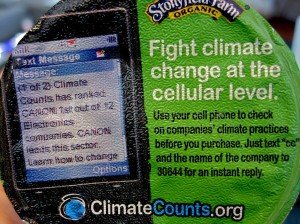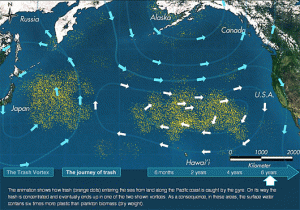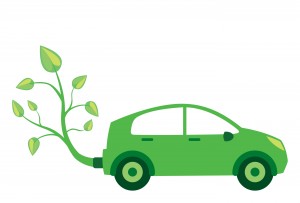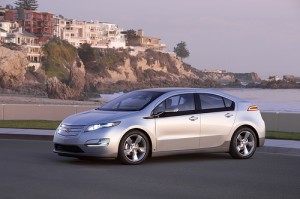A word about plastics, the bete noire of the environmental movement, and a lesson in fuzzy math, environmental style.
 Plastics, as we’ve been taught since the mid 1970s, are evil. Lucifer, sitting on his throne in hell, handed the formula directly to inventor Alexander Parkes in 1862, and life hasn’t been right since. Made from petroleum and breaking down into hazardous chemicals – when they break down at all – plastics are symbolic for everything that’s wrong with the world economy. There is no better example of plastic’s malignant effect than the spread of bottled water. Plastic water bottles increase petroleum use, clog landfills and foul the oceans, according to environmental groups. Every time I buy water in a plastic bottle, I feel like I’ve personally flown up to Prince William Sound and rolled a sea otter in Alaskan sweet crude. Plastic bottles have gotten such a bad rap lately that you might as well be carrying a mustard gas canister out of the MobileMart as 16 ounces of Poland Springs, in many environmentalists’ estimation. You can’t care about the environment and drink bottled water, goes the new orthodoxy.
Plastics, as we’ve been taught since the mid 1970s, are evil. Lucifer, sitting on his throne in hell, handed the formula directly to inventor Alexander Parkes in 1862, and life hasn’t been right since. Made from petroleum and breaking down into hazardous chemicals – when they break down at all – plastics are symbolic for everything that’s wrong with the world economy. There is no better example of plastic’s malignant effect than the spread of bottled water. Plastic water bottles increase petroleum use, clog landfills and foul the oceans, according to environmental groups. Every time I buy water in a plastic bottle, I feel like I’ve personally flown up to Prince William Sound and rolled a sea otter in Alaskan sweet crude. Plastic bottles have gotten such a bad rap lately that you might as well be carrying a mustard gas canister out of the MobileMart as 16 ounces of Poland Springs, in many environmentalists’ estimation. You can’t care about the environment and drink bottled water, goes the new orthodoxy.
So let’s stop buying water in plastic bottles! When demand slumps, the bottled water companies will have to use a more environmentally friendly material, like glass. Glass isn’t made from oil, it recycles easily and it doesn’t degrade in landfills. That’s all true, but glass breaks more easily than plastic. Breakage increases waste and spoilage. More waste means producing more to meet demands – which takes energy. Also, because it doesn’t degrade, glass permanently takes up landfill space. It’s heavier than plastic, so it requires more energy to ship.
Okay, so maybe glass isn’t the answer. How about boxes, like the kind kids drink juice from? They’re light and durable. They’re also difficult to recycle unless the thin layers of plastic and metal insulation are stripped from the paper, according to the New York Times. Metal cans? Very recyclable, but it takes a ton of energy to produce and recycle metal – especially aluminum.
 The point here isn’t to stick up for unfettered use of plastic bottles. The debate around plastic bottles and their potential replacements is symbolic of a larger issue – the complexity of “environmental math,” or trying to figure out when doing something with environmental motives has unintended consequences. The way our economy is geared right now, if we’re going to cut down on something like plastic bottles, we expect another disposable alternative. That’s the key word – disposable.
The point here isn’t to stick up for unfettered use of plastic bottles. The debate around plastic bottles and their potential replacements is symbolic of a larger issue – the complexity of “environmental math,” or trying to figure out when doing something with environmental motives has unintended consequences. The way our economy is geared right now, if we’re going to cut down on something like plastic bottles, we expect another disposable alternative. That’s the key word – disposable.
Anyone wise to environmental issues knew right away that the plastic bottle scenario above is a red herring. The best alternative to a disposable plastic water bottle isn’t making a disposable bottle out of another material; the best alternative is a reusable water bottle. It can be made of metal or plastic, as long as it isn’t thrown away. Because what we use is the smaller part of our environmental conundrum. Every product and commodity has an environmental price tag. The bigger problem is that we use too much of everything, and our appetite is growing. As far back as 1995, United Nations writer John Young reported in “Towards a New Culture of Consumption” that “materials use has grown far faster than population: in the US, total consumption of virgin raw materials was 17 times greater in 1989 than it was in 1900, compared with a threefold increase in population.” Metal, glass and plastic consumption is also increasing. Reducing use of one commodity usually means using more of another one, unless our disposable society changes. We have to stop making stuff to throw away.
The problem is that reducing consumption is the maiden aunt of the environmental movement. It bakes pies and babysits the kids so its sexier siblings – solar energy, wind power, biofuels and recycling – can go out on the town with media and investors. There is no industry backing conservation. In fact, considering that our economy is based on consumption, the business community is probably uneasy about the reduction message. Government, heavily influenced by industry, won’t push the reduction agenda. (If you have any doubts, consider what happened to the nutrition pyramid by the time the food industries weighed in.)
If this most important part of the oft-repeated “reduce, reuse, recycle” mantra is to catch on, then, it’s going to have to be a grassroots movement. Ten years ago, it would have been unrealistic to expect a national campaign of “turn it down, turn it off, don’t use it, don’t buy it” to take off on its own without some big patron saint at the national level. But we live in the viral marketing age fueled by the Internet. A growing crop of Web sites like carbonfootprint.com and the World Wildlife Fund site advise consumers on simple measures that make a big difference. A small example: washing clothes in cold instead of warm water – which is reducing electrical usage – saves the average consumer $167 per year, according to the blog Saving Electricity. The Rocky Mountain Institute estimates a lower dollar savings – $61 – but a higher percentage – 85 – and 1,281 fewer pounds of CO2 released into the environment.
Since you’re reading an environmental blog, chances are you knew that already. So here’s an extra credit assignment: find a good energy or material conservation tip on a Web site that you like, and e-mail it to people you know who are least likely to be environmentally aware. Tell them how much they can save washing clothes in cold water, or turning the air conditioner down two degrees. You could be planting the seed of a reduction revolution. And what the heck, put a reusable water bottle in their Christmas stocking. It just might catch on.
